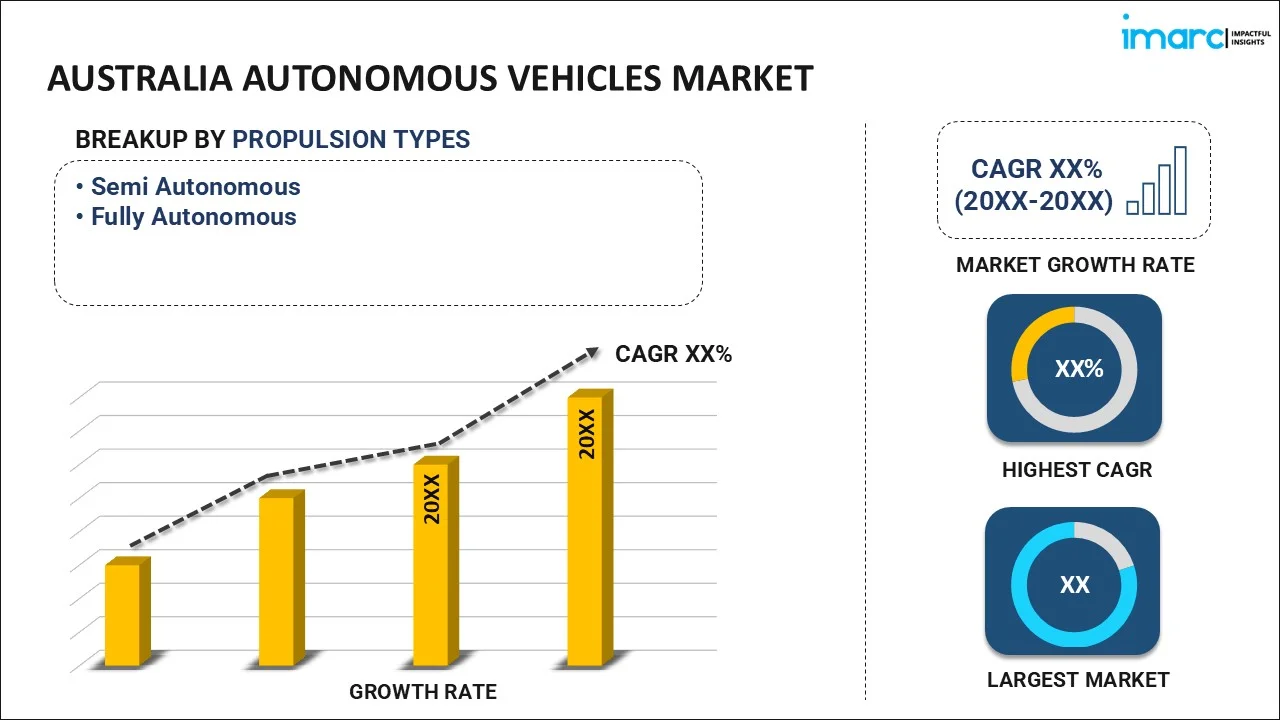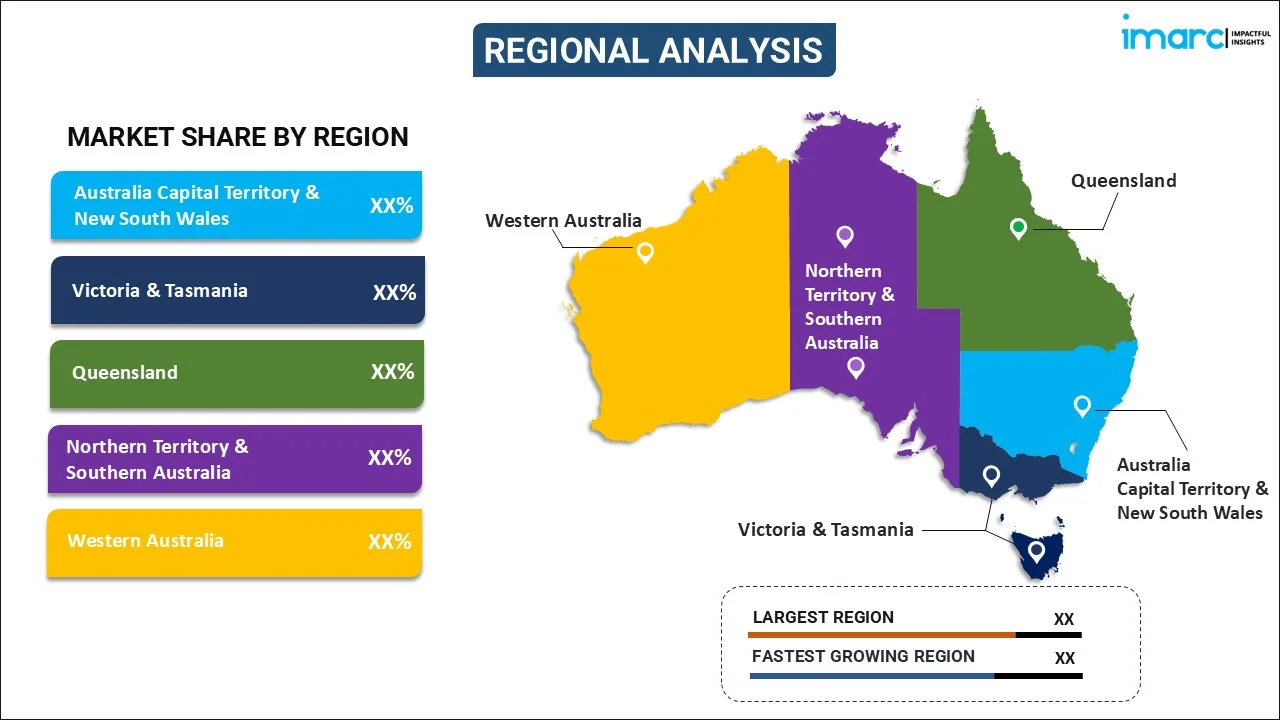
Australia Autonomous Vehicles Market Size, Share, Trends and Forecast by Propulsion Type, Level, Vehicle Type, and Region, 2025-2033
Australia Autonomous Vehicles Market Overview:
The Australia autonomous vehicles market size reached USD 1.34 Billion in 2024. Looking forward, IMARC Group expects the market to reach USD 15.78 Billion by 2033, exhibiting a growth rate (CAGR) of 28.80% during 2025-2033. The Australia autonomous vehicles market share is expanding, driven by the rising pressure to reduce carbon emissions, favorable government policies focusing on the implementation of road safety measures, continual improvements in sensor and camera technologies and smart infrastructure, and the increasing number of collaborations between automotive and tech companies.
|
Report Attribute
|
Key Statistics
|
|---|---|
|
Base Year
|
2024
|
|
Forecast Years
|
2025-2033
|
|
Historical Years
|
2019-2024
|
| Market Size in 2024 | USD 1.34 Billion |
| Market Forecast in 2033 | USD 15.78 Billion |
| Market Growth Rate (2025-2033) | 28.80% |
Australia Autonomous Vehicles Market Trends:
Increasing demand for automotive safety and energy-efficient vehicles
The rising need for advanced automotive safety and fuel-efficient vehicles is impelling the Australia autonomous vehicles market growth. The introduction of stringent emission regulations has motivated car manufacturers to develop next-generation clean energy vehicles such as battery electric vehicles (BEVs) and electric vehicles (EVs). In May 2024, The Australian Government declared USD 154 Million to enforce the New Vehicle Efficiency Standard, aiming to provide more options for fuel-efficient vehicles that can lower energy expenses and decrease transport pollution. The purchase of vehicles that are emission-free or fuel and energy-saving, equipped with advanced technologies and a high level of autonomy to operate is on the rise. This can be attributed to increasing prices of fossil fuels, which are in limited supply. As a result, they achieve improved effectiveness by driving effectively and managing energy usage. The manufacturers are also focusing on working together with developers of autonomous car technology to fulfill the needs of the high population.
Expansion of ride-sharing services
The expansion of ride-sharing services is offering a favorable Australia autonomous vehicles market outlook. With high employment rates and people going to offices, the need for ride-share services is high. As per the data provided on the official website of the Australian Bureau of Statistics, in February 2024, 14 Million individuals were in employment in Australia. 2.6 Million individuals began their employment in the same month. Ride-sharing platforms have transformed urban mobility by giving convenient, cost-effective, and flexible transportation options. As these services grow, there is a high demand for more efficient and scalable transportation solutions, which autonomous vehicles can address. Furthermore, the increasing adoption of ride-sharing services highlights a shift in user preferences from personal car ownership to shared mobility. Autonomous vehicles can reduce operational costs for ride-sharing companies by eliminating the need for human drivers, thereby allowing these companies to offer more competitive pricing and improved service availability. Moreover, they align well with the business model of ride-sharing services, which often aim to maximize vehicle utilization. This capability allows ride-sharing companies to optimize their fleet management and improve service frequency, meeting the increasing requirement for on-demand transportation. Besides, the integration of these vehicles into ride-sharing fleets also addresses some of the challenges associated with human drivers, such as inconsistent service quality and varying driving skills. By deploying autonomous vehicles, ride-sharing companies can ensure a more uniform and reliable user experience. Additionally, AVs can contribute to better safety and lower accident rates, further enhancing the appeal of ride-sharing services.
Australia Autonomous Vehicles Market Segmentation:
IMARC Group provides an analysis of the key trends in each segment of the market, along with forecasts at the region level for 2025-2033. Our report has categorized the market based on propulsion type, level, and vehicle type.
Propulsion Type Insights:

- Semi Autonomous
- Fully Autonomous
The report has provided a detailed breakup and analysis of the market based on the propulsion types. This includes semi autonomous and fully autonomous.
Level Insights:
- Level 1
- Level 2
- Level 3
- Level 4
- Level 5
A detailed breakup and analysis of the market based on the levels have also been provided in the report. This includes level 1, level 2, level 3, level 4, and level 5.
Vehicle Type Insights:
- Passenger Car
- Commercial Car
The report has provided a detailed breakup and analysis of the market based on the vehicle types. This includes passenger car and commercial car.
Regional Insights:

- Australia Capital Territory & New South Wales
- Victoria & Tasmania
- Queensland
- Northern Territory & Southern Australia
- Western Australia
The report has also provided a comprehensive analysis of all the major regional markets, which include Australia Capital Territory & New South Wales, Victoria & Tasmania, Queensland, Northern Territory & Southern Australia, and Western Australia.
Competitive Landscape:
The market research report has also provided a comprehensive analysis of the competitive landscape. Competitive analysis such as market structure, key player positioning, top winning strategies, competitive dashboard, and company evaluation quadrant has been covered in the report. Also, detailed profiles of all major companies have been provided.
Australia Autonomous Vehicles Market News:
- In January 2025, Applied EV, the Melbourne-based automotive manufacturing firm, launched the newly developed autonomous logistics vehicle, known as the "Blanc Robot”. It aimed to enhance the intelligence and safety of last-mile logistics in Australia. The firm revealed its intention to launch the initial 100 units of the Blanc Robot by the middle of 2025.
- In October 2024, Scania and Regroup, an Australia-based services provider, announced the introduction of the world's first fleet of Scania autonomous in-pit mining trucks in the Pilbara, Australia, with deployment scheduled at Element 25's Butcherbird mine. Scania, Regroup, and Element 25 teamed up to finalize the details of this solution and to synchronize with the expansion of the Butcherbird mine in the country.
Australia Autonomous Vehicles Market Report Coverage:
| Report Features | Details |
|---|---|
| Base Year of the Analysis | 2024 |
| Historical Period | 2019-2024 |
| Forecast Period | 2025-2033 |
| Units | Billion USD |
| Scope of the Report |
Exploration of Historical Trends and Market Outlook, Industry Catalysts and Challenges, Segment-Wise Historical and Future Market Assessment:
|
| Propulsion Types Covered | Semi Autonomous, Fully Autonomous |
| Levels Covered | Level 1, Level 2, Level 3, Level 4, Level 5 |
| Vehicle Types | Passenger Car, Commercial Car |
| Regions Covered |
Australia Capital Territory & New South Wales, Victoria & Tasmania, Queensland, Northern Territory & Southern Australia, Western Australia |
| Customization Scope | 10% Free Customization |
| Post-Sale Analyst Support | 10-12 Weeks |
| Delivery Format | PDF and Excel through Email (We can also provide the editable version of the report in PPT/Word format on special request) |
Key Questions Answered in This Report:
- How has the Australia autonomous vehicles market performed so far and how will it perform in the coming years?
- What is the breakup of the Australia autonomous vehicles market on the basis of propulsion type?
- What is the breakup of the Australia autonomous vehicles market on the basis of level?
- What is the breakup of the Australia autonomous vehicles market on the basis of vehicle type?
- What are the various stages in the value chain of the Australia autonomous vehicles market?
- What are the key driving factors and challenges in the Australia autonomous vehicles market?
- What is the structure of the Australia autonomous vehicles market and who are the key players?
- What is the degree of competition in the Australia autonomous vehicles market?
Key Benefits for Stakeholders:
- IMARC’s industry report offers a comprehensive quantitative analysis of various market segments, historical and current market trends, market forecasts, and dynamics of the Australia autonomous vehicles market from 2019-2033.
- The research report provides the latest information on the market drivers, challenges, and opportunities in the Australia autonomous vehicles market.
- Porter's five forces analysis assist stakeholders in assessing the impact of new entrants, competitive rivalry, supplier power, buyer power, and the threat of substitution. It helps stakeholders to analyze the level of competition within the Australia autonomous vehicles industry and its attractiveness.
- Competitive landscape allows stakeholders to understand their competitive environment and provides an insight into the current positions of key players in the market.
Need more help?
- Speak to our experienced analysts for insights on the current market scenarios.
- Include additional segments and countries to customize the report as per your requirement.
- Gain an unparalleled competitive advantage in your domain by understanding how to utilize the report and positively impacting your operations and revenue.
- For further assistance, please connect with our analysts.
 Inquire Before Buying
Inquire Before Buying
 Speak to an Analyst
Speak to an Analyst
 Request Brochure
Request Brochure
 Request Customization
Request Customization




.webp)




.webp)












